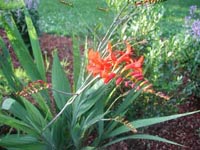Resource Library
Plant of the Week: Montbretia (Crocosmia)
The University of Arkansas System Division of Agriculture does not promote, support or recommend plants featured in "Plant of the Week." Please consult your local Extension office for plants suitable for your region.
Plant of the Week
Crocosmia, Montbretia
Latin: Crocosmia x crocosmiflora

Gardeners, by and large, are optimists. Without a healthy dose of optimism, few would bother with the work required to plan, plant and maintain a garden.
But optimism is by no means the realm of just the gardener. Blooming in my garden now is a clump of million dollar flowers - a token of my wife’s deeply held belief that she is destined to one day win the Publisher’s Clearinghouse Sweepstake.
The million dollar plant is a clump of Crocosmia x crocosmiflora ‘Lucifer,’ a robust, cormous perennial in the iris family. Lucifer has sword-shaped, 18-inch long leaves that are pleated down their length and borne along the bottom half of the 4-foot tall stem. Each stem terminates in four branches with each lined with a pair of rows of bright orange-red flowers.
The basal flowers open first on each inflorescence. The flowers themselves have an inch-long tubular throat and terminate in six petals, three of which are larger than their neighbors. The inflorescence has a graceful arching habit reminiscent of a bird in flight.
My wife Jolene is a confirmed optimist who has for years, with due diligence, filled out all the seemingly endless stream of Publisher’s Clearinghouse mail-in forms. I’m slow to catch on, so it took a while for me to realize that her reluctance to go anywhere on New Year’s Day was not a new interest in college football. Instead, it was her fear of not being home when Ed McMann showed up with her check.
A couple years ago all of this form-filling paid off when she received a package from the company. By its shape it obviously wasn’t a check but, like any optimist worth her salt, she had visions of large jewels, expensive watches and other such gifts worthy of a company that routinely gives away million dollar checks. Her disappointment was profound when she ripped open the package and found a bunch of small, shriveled flower bulbs.
Knowing something of the flower bulb industry, I was surprised to find the bulbs and corms were not just small, they were "propagator bulbs" - the tiny starts that bulb farmers plant back in their fields that will be large enough to sell in a couple more years. And talk about shriveled. They looked as if they had been stored in some warehouse and forgotten for a long time.
Of the six species enclosed, only Lucifer survived long enough to flower. Each July it serves as a reminder of the hope that springs eternal in all of us.
The five species of Crocosmia are native to South Africa and have been grown in European gardens since the middle of the 19th century. The first hybrids in the group were done by the famous French nurseryman, Victor Lemoine of Nancy, who was one of the most prolific plant breeders of his period. I find no mention of Lucifer being one of Lemoine’s hybrids, and the name does not seem typical of the flowery French names he preferred, but his breeding efforts certainly lead the way for future generations of breeders. Of the Crocosmias seen in American gardens, Lucifer is by far the most common.
Lucifer Crocosmia is hardy throughout Arkansas. The corms should be planted 5 inches deep in a well drained, but moderately moist, sunny site. It will persist for years, but every three to five years springtime division will prevent overcrowding of the clump and assure continued flowering. If left unstaked, the plants often lean to one side in a graceful arch. Once the plants finish flowering, cut off the spikes and the pleated foliage is an attractive addition to the greenery in the perennial border.
By: Gerald Klingaman, retired
Extension Horticulturist - Ornamentals
Extension News - July 3, 2003
The University of Arkansas System Division of Agriculture does not maintain lists of retail outlets where these plants can be purchased. Please check your local nursery or other retail outlets to ask about the availability of these plants for your growing area.